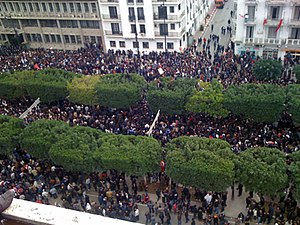
Back Арабтәи ааԥынра Abkhazian Arabiese Lente Afrikaans الربيع العربي Arabic الربيع د الشعوب ARY الربيع العربى ARZ Primavera Árabe AST Ərəb baharı Azerbaijani Ғәрәп яҙы Bashkir Arabischa Friahling BAR Арабская вясна Byelorussian
| Arab Spring | |
|---|---|
 Protesters in Tunisia (January 2011) | |
| Date | 17 December 2010 – 2012 |
| Location | North Africa, Middle East (i.e. MENA or "Arab world")
|
| Casualties | |
| Death(s) | 61,080+ (International estimate; see table below[broken anchor]) |
The Arab Spring (Arabic: الربيع العربي, ar-rabīˁ al-ˁarabī) is a wave of protests and demonstrations that happened in the Middle East and North Africa starting on 17 December 2010. The self-immolation of Tunisian street vendor Mohamed Bouazizi ignited the Tunisian Revolution, which quickly spread all over the MENA region.
Almost all Arab countries were affected by the Arab Spring, through varying degrees of social and political unrest. In Tunisia, Egypt, Libya, Yemen, Bahrein and Syria, the influence of the Arab Spring is the most notable. However, major protests also occurred in many other Middle Eastern states.[12]
People went to protest out of anger against corruption and their often oppressive and authoritarian leaders. The demands of the protester were similar throughout the region. Common demands were freedom, justice, equal rights, economic opportunities, and democracy.[12][13]
Protestors were very efficient in mobilising people, communicating, and providing information. The methods they used strongly contributed to the course of the Arab Spring.[14] Moreover, pan-Arab TV programmes, social media and other forms of pan-Arab Internet networks contributed to the high degrees of synchronisation of the protests.[12]
The Arab Spring heavily altered the political environment of the Middle East. By 2012, most of the governments involved had either been defeated and replaced or had suppressed the protests. However, in most countries, the demands of the protestors were not met, leaving them discontent and leaving the country in a state of unrest and instability.
- ↑ Volpi, Frédéric. "Algeria versus the Arab spring." Journal of Democracy 24.3 (2013): 104-115
- ↑ https://www.aljazeera.com/news/2011/1/15/tunisias-ben-ali-flees-amid-unrest
- ↑ https://www.telegraph.co.uk/news/worldnews/africaandindianocean/libya/8344034/Libya-civil-war-breaks-out-as-Gaddafi-mounts-rearguard-fight.html
- ↑ Ma'oz, Moshe (2 January 2014). "The Arab Spring in Syria: Domestic and regional developments". Dynamics of Asymmetric Conflict. 7 (1): 49–57.
- ↑ https://www.spiegel.de/international/world/it-will-not-stop-syrian-uprising-continues-despite-crackdown-a-753517.html
- ↑ And, Muhammed Kürsad Ozekin; Akkas, Hasan Hüseyin (1 February 2014). "An Empirical Look to the Arab Spring: Causes and Consequences". Alternatives: Turkish Journal of International Relations. 13 (1&2). doi:10.21599/atjir.15384. ISSN 1303-5525.
- ↑ "Yemen's Hijacked Revolution". Human Rights Watch. 26 September 2011. Retrieved 14 May 2023.
- ↑ https://www.reuters.com/article/lebanon-protest-idAFLDE71Q08L20110227
- ↑ Worrall, J. (2012). Oman: the" forgotten" corner of the Arab Spring. Middle East Policy, 19(3).
- ↑ https://www.nytimes.com/2011/01/28/world/middleeast/28yemen.html
- ↑ And, Muhammed Kürsad Ozekin; Akkas, Hasan Hüseyin (1 February 2014). "An Empirical Look to the Arab Spring: Causes and Consequences". Alternatives: Turkish Journal of International Relations. 13 (1&2).
- ↑ 12.0 12.1 12.2 Cite error: The named reference
:3was used but no text was provided for refs named (see the help page). - ↑ Cite error: The named reference
:2was used but no text was provided for refs named (see the help page). - ↑ Cite error: The named reference
:4was used but no text was provided for refs named (see the help page).
© MMXXIII Rich X Search. We shall prevail. All rights reserved. Rich X Search